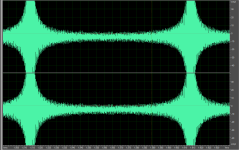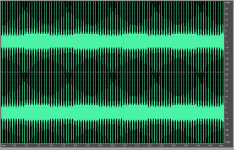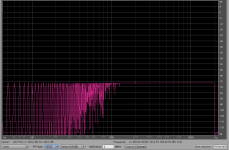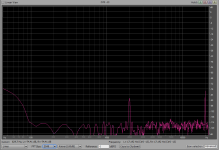EdGr, may suggest you call it -40dB FS & -80dB FS in future, instead of 1% and 0.01%.
1% & 0.01% leads people to believe they are listening to a THD test.
I still haven't dug up my headphones.
Beach bums are lazy and the phones are under a pile of diving & boating junk. But I'm diving tomorrow so maybe the headphones will reveal themselves 😊
1% & 0.01% leads people to believe they are listening to a THD test.
I still haven't dug up my headphones.
Beach bums are lazy and the phones are under a pile of diving & boating junk. But I'm diving tomorrow so maybe the headphones will reveal themselves 😊
Saying 0.1% & 0.01% is good when you are testing distortion but is confusing when you are not.Yes. I wanted to test distortion, but the 2KHz sine is not normal distortion.
For this test where it is the 2kHz sine which is to be detected, saying -40dB Full Scale (FS) and -80dB FS is much clearer.
Energy in clicks is low and their repetition frequency is low as well. I think that is the reason why it is possible to detect sine beeps. You need good headphones with good isolation from ambient noise. And good DAC and headphone amp.@PMA - That is impressive. The 2KHz sine is 80dB below the peak and 1.6dB above the floor.
Ed
I am still wondering what this test has in common with phono preamp topologies, because it started as a result of phono preamps discussion.
It cannot be called "distortion" as it only confuses laymen audience. Some of them then say they heard 0.01% distortion, which is a plain nonsense. You might say you are testing SFDR, spurious free dynamic range. But not the distortion. Distortion term is commonly used for nonlinear distortion, that may be represented as harmonic distortion, intermodulation distortion, or else, depending on input signal composition.@kgrlee - Yes. I wanted to test distortion, but the 2KHz sine is not normal distortion.
Ed
Nonlinear distortion creates frequencies that were not present in the original signal.
Yes but peaks have 0.1s intervals between them. This is a long time for the ear to recover and be able to detect the interleaved beeps.The 2KHz sine is 80dB below the peak and 1.6dB above the floor.
Click distance
 Y-axis zoomed
Y-axis zoomed 
another view - visible beeps

Overall spectrum, seemingly flat and uniform

Spectrum of beeps between the clicks, short FFT

Last edited:
(2) is showing that the "+1 error" is audible (to some people).PMA said:I am still wondering what this test has in common with phono preamp topologies, because it started as a result of phono preamps discussion.
(4) is showing that signals at -80dB are audible.
My conclusion is that EQ accuracy and distortion need to be better than what some phono pre-amps have.
I stated in post #1 that the 2KHz sine is a proxy for distortion, but I see how the subtlety could be lost.PMA said:Distortion term is commonly used for nonlinear distortion, that may be represented as harmonic distortion, intermodulation distortion, or else, depending on input signal composition. Nonlinear distortion creates frequencies that were not present in the original signal.
BTW, the math that created the waveforms is very simple.
Ed
(2) Time 30-60s: EQ +3dB at 200KHz
I don't understand what I should/could hear here if I could.(2) is showing that the "+1 error" is audible (to some people).
Could you please discribe what is to expect to hear?
?? Can't have anything to do with 200kHz 😳
I can hear (4) even with my built-in netbook speaker, but not (2), which sounds the same as (1) to me.
Last edited:
I miss-clicked one 🙂2025-03-08 14:21:22
File A: test1.wav
SHA1: 9a7849101aa848c5fa037aed8e11f38ed0c3a0c9
File B: test4.wav
SHA1: 077344e1d886d2a88202f1f9eed6483cbb460f1e
Output:
Default : Primary Sound Driver
Crossfading: NO
14:21:22 : Test started.
14:21:48 : Test restarted.
14:21:48 : 01/01
14:22:01 : Test restarted.
14:22:01 : 01/02
14:22:15 : Test restarted.
14:22:15 : 02/03
14:22:28 : Test restarted.
14:22:28 : 03/04
14:22:37 : Test restarted.
14:22:37 : 04/05
14:22:55 : Test restarted.
14:22:55 : 05/06
14:23:02 : Test restarted.
14:23:02 : 06/07
14:23:12 : Test restarted.
14:23:12 : 07/08
14:23:24 : Test restarted.
14:23:24 : 08/09
14:23:36 : Test restarted.
14:23:36 : 09/10
14:23:48 : Test restarted.
14:23:48 : 10/11
14:23:56 : Test restarted.
14:23:56 : 11/12
14:24:08 : Test restarted.
14:24:08 : 12/13
14:24:16 : Test restarted.
14:24:16 : 13/14
14:24:26 : Test restarted.
14:24:26 : 14/15
14:24:40 : Test restarted.
14:24:40 : 15/16
14:24:40 : Test finished.
----------
Total: 15/16
p-value: 0.0003 (0.03%)
-- signature --
e9381eb1f5d605ce36081edca63101fc0e5ea6ca
? so there are 20khz beeps between the clicks?the beeps in (2) are much louder then in (4).
No wonder I can't here them. Neither the Netbook/Speaker nor my ears can do that.
In (2) so there are 200kHz beeps? One is asked to hear them? 200kHz...come on...
I must have misunderstood....
Last edited:
There are no beeps in 1 and 2, but there is a gentle rise in the frequency response at high frequencies. It would be +3 dB at 20 kHz and at 200 kHz, respectively, if the signal had not been band limited to 20 kHz.
That's strange, as (2) is not supposed to have beeps. Do you mean (3) and (4)?Impossible, the beeps in (2) are much louder then in (4).
- Home
- Source & Line
- Analogue Source
- Take the click and pop challenge